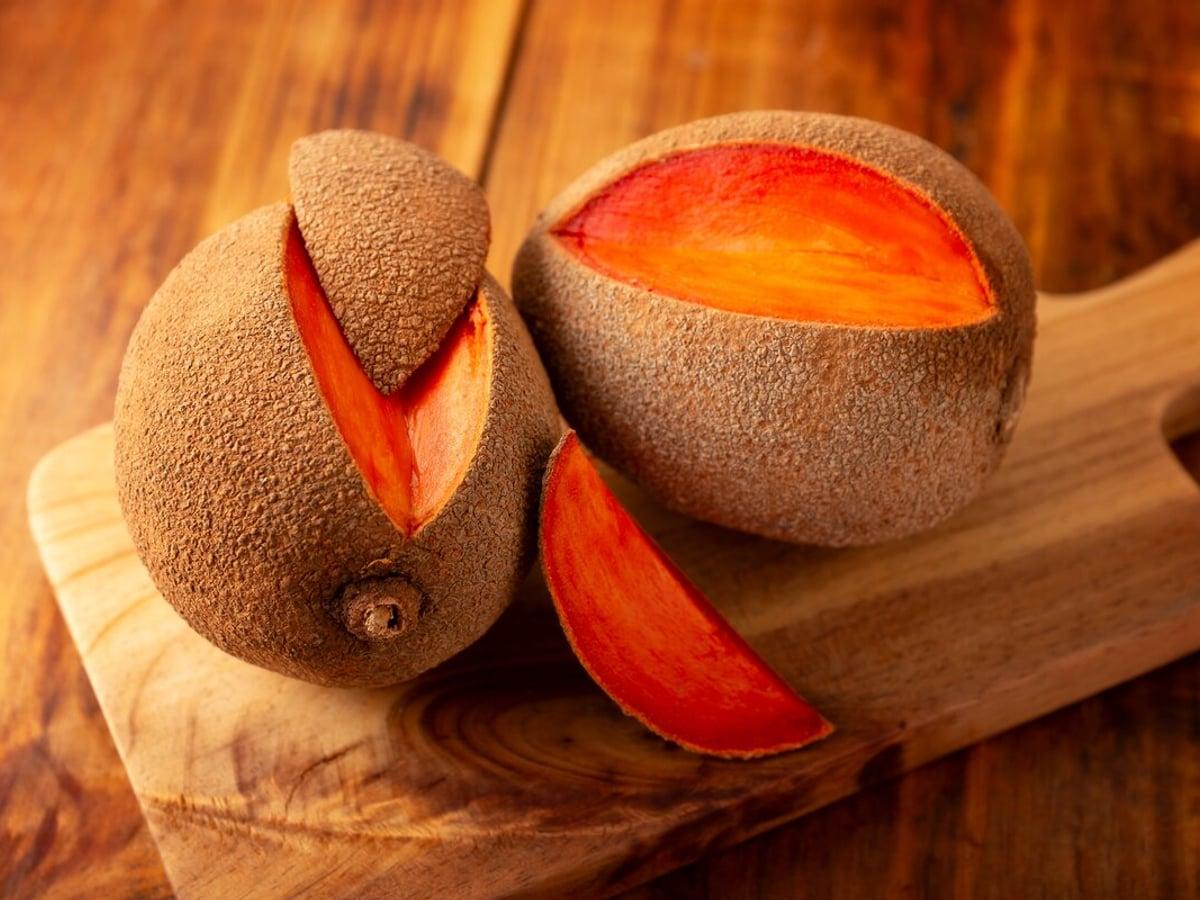Mamey: Traditional Cuban Ingredient

Mamey is an essential tropical fruit in Cuban cuisine, known for its sweet flavor and versatility.
Full Definition
Mamey is a tropical fruit with an intense orange color, widely used in Cuban cuisine for its sweet taste and creamy texture.
In Cuban gastronomy, mamey is a fundamental ingredient, used in a variety of traditional dishes and drinks. Its unique flavor and cultural value make it a symbol of Cuba's culinary richness.
Origin and History
Mamey, also known as mamey sapote, has its roots in the tropical regions of Central America and the Caribbean. In Cuba, the fruit has been part of the local diet since pre-Columbian times, when the Taínos already cultivated and consumed it. With the arrival of Spanish colonizers, mamey became further integrated into Cuban culinary culture, being mentioned in historical documents as a fruit appreciated for its flavor and nutritional value.
An interesting fact is that mamey was one of the fruits Christopher Columbus encountered during his voyages to the New World. In the work of Nitza Villapol, one of Cuba's most influential chefs, the use of mamey in desserts and milkshakes is highlighted, reflecting its importance in traditional Cuban cuisine.
Main Characteristics
Mamey is an oval-shaped fruit with a rough brown skin. Its pulp is a vibrant orange color, with a smooth and creamy texture. The flavor of mamey is sweet, with notes of almond and vanilla, making it ideal for desserts and drinks.
The aroma of mamey is sweet and fruity, similar to other tropical fruits like mango and papaya. Its creamy texture makes it a versatile ingredient, perfect for milkshakes, ice creams, and jams.
Nutritional Properties
Mamey is a rich source of vitamins A and C, essential for eye health and the immune system. It also contains dietary fiber, which aids digestion, and antioxidants that protect against cellular damage.
Additionally, mamey is low in fat and calories, making it a healthy option to include in the diet. However, people with allergies to tropical fruits should consume it with caution.
Varieties and Qualities
In Cuba, several varieties of mamey can be found, with the most common being mamey colorado and mamey de Santo Domingo. Both varieties are appreciated for their sweet flavor and creamy texture.
The quality of mamey is determined by its ripeness; a ripe mamey should have a slightly soft skin to the touch and a sweet aroma. In Cuban markets, local producers carefully select mameys to ensure their freshness and flavor.
Culinary Uses and Key Dishes
Mamey is mainly used in desserts and drinks in Cuban cuisine. Its sweet flavor makes it ideal for preparing milkshakes, ice creams, and jams. It is also used in the making of traditional sweets like mamey casquitos.
Mamey Milkshake: A refreshing milkshake made with mamey, milk, and sugar.
Mamey Ice Cream: A creamy and sweet dessert, perfect for hot days.
Mamey Jam: A delicious jam to spread on bread and cookies.
Mamey Casquitos: Traditional sweets made with mamey pulp.
Mamey Flan: A classic Cuban dessert with a tropical twist.
Detailed Preparation Techniques
To prepare a mamey milkshake, it is recommended to use ripe mamey, peel the fruit, and cut the pulp into pieces. Then, mix it with milk and sugar in a blender until smooth. The milkshake is served cold.
In the preparation of mamey ice cream, the pulp is mixed with cream and sugar, and frozen in an ice cream maker. For the jam, the pulp is cooked over low heat with sugar and lemon juice until it thickens.
Step-by-Step Recipes
Mamey Milkshake: Ingredients: 1 ripe mamey, 1 cup of milk, 2 tablespoons of sugar. Steps: Peel and cut the mamey, mix with milk and sugar in a blender, serve cold.
Mamey Ice Cream: Ingredients: 2 cups of mamey pulp, 1 cup of cream, 1/2 cup of sugar. Steps: Mix all ingredients, freeze in an ice cream maker.
Mamey Casquitos: Ingredients: 1 mamey, 1 cup of sugar, 1/2 cup of water. Steps: Peel and cut the mamey into wedges, cook with sugar and water until caramelized.
Storage and Preservation
Mamey should be stored at room temperature until ripe. Once ripe, it can be refrigerated to prolong its freshness. Mamey pulp can also be frozen for later use.
Chef's Tips and Secrets
To intensify the flavor of mamey in milkshakes, it is recommended to add a pinch of cinnamon or vanilla. When preparing ice cream, letting the mixture rest in the refrigerator before freezing helps improve the texture.
Frequently Asked Questions (FAQ)
How to know if a mamey is ripe?
A ripe mamey should have a soft skin and a sweet aroma.
Can mamey be frozen?
Yes, mamey pulp can be frozen for later use.
What traditional Cuban dishes use mamey?
Mamey is used in milkshakes, ice creams, jams, and mamey casquitos.
Does mamey have health benefits?
Yes, it is rich in vitamins A and C, fiber, and antioxidants.
Is mamey suitable for people with allergies?
People with allergies to tropical fruits should be cautious.
Alternative Names and Common Confusions
Mamey is also known as mamey sapote. It should not be confused with mamey colorado, which is a different variety. Although both are called “mamey”, they are not from the same plant family. In Cuba, when people say mamey, they almost always refer to mamey sapote (Pouteria sapota), the most used in milkshakes and desserts. Mamey colorado (Mammea americana) is also known and consumed, but it has a different texture and flavor; it is used less in pastries and more as fresh fruit.
The Term in Popular Speech
"That dessert tastes like mamey, how delicious!"
"Let's make a mamey milkshake to cool down."
"Mamey ice cream is my favorite in the summer."
Usage Examples
- •Mamey milkshake is a refreshing and popular drink in Cuba.
- •Mamey ice cream is a traditional dessert enjoyed throughout the island.
- •Mamey casquitos are typical sweets prepared on special occasions.